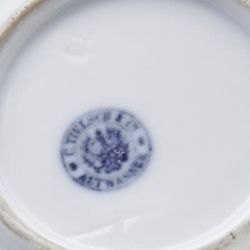
За свою более чем 150-летнюю историю фарфоровая фабрика, основанная Карлом Тильшем в 1845 году в Альтвассере, позднее Вальденбурге, (Нижняя Силезия) сменила не только с пол-дюжины имен, но даже и страну происхождения. Мы проследим развитие прославленной немецкой фабрики по ключевым моментам в её истории.
Porzellanfabrik C. Tielsch & Co. (с 1845 по 1917 гг.).
С момента своего основания мануфактура Карла Тильша очень быстро стала одним из лидеров в фарфоровом производстве Германии. Причину подобного взлёта можно объяснить тем, что с самого начала ассортимент продукции был очень широк. Он включал и утварь для дома, и профессиональную посуду. Много внимания уделялось производству высококачественного фарфора ручной работы. Нельзя не отметить и то, что на фабрику приглашались лучшие художники и декораторы своего времени.
Первоначально Карл Тильш маркировал свою продукцию заглавными буквами TPM, что означало Tielsch Porzellan-Manufactur. Это клеймо походило на клеймо Королевской Фарфоровой Мануфактуры - KPM (Königlich Preußische Porzellanmanufaktur). В связи с этим Карл Тильш был вынужден видоизменить свою марку, добавив изображение кадуцея - жезла антисного бога Гермеса, обвитого двумя змеями. Но и этот вариант использовался недолго. В 1847 году кадуцея сменил орел, который в тех или иных вариациях использовался более ста лет.
Рисунок орла тоже был не единственным в своем роде. Подобное клеймо уже использовалось Берлинской фарфоровой мануфактурой Ф.А. Шуманна (подразделением KPM) с 1836 года. Карлу Тильшу нравились изделия этой фабрики, и он некоторое время работал в подобном стиле. Так что и орел вызвал проблемы. Директор KPM подал жалобу на Тильша в Министерство финансов, что привело к очередной смене марки в 1850 году. В этот раз было выбрано изображение пикирующего голубя, держащего веточку в лапках. Конечно сходство с орлом Королевской Фарфоровой Мануфактуры осталось, но, видимо, различия в рисунках удовлетворили пострадавшую сторону, и жалобы на Тильша прекратились.
Карл Тильш, член Торговой Палаты, удостоенный звания советника коммерции умирает в 1882 году в возрасте 67 лет. Эта смерть не остается незамеченной, так как он был не только успешным бизнесменом, но и известным социальным деятелем. Одной из главных заслуг Карла Тильша является учреждение пенсионного фонда по нетрудоспособности для рабочих. Труд отца продолжает его сын Эдмонт Тильш, офицер запаса, бизнесмен и благотворитель. Эдмонт проводит расширение производства, открыв дополнительный филиал в Альтвассере в 1906 году. Новые мощности также являются испытательной базой, на которой в этом же году были успешно проведены последние испытания угольной туннельной печи полного цикла для обжига фарфора длинной в 64 метра. Новая печь производит революцию в индустрии производства фарфора. За свои профессиональные заслуги и социальную деятельность Эдмонт Тильш был награжден Орденом Красного Орла 4-го класса и произведен в пэры, получив титул кавалер Ордена Красного Орла и советник коммерции Эдмонт фон Тильш.
В 1913 году предприятие достигло пика развития. На альтвассерской мануфактуре трудились 1500 рабочих, включая 270 гончаров и 110 декораторов. В середине 1914 года каталог продукции фабрики содержал 1637 единиц. Может показаться, что это скромное число, однако стоит учитывать, что одна единица, допустим кофейник, включала в себе около 200 различных вариантов размеров и декора. Компания успешно пережила годы войны. В 1917 году власти города потребовали сократить производство до 60% с целью сохранения ресурсов. Чтобы восполнить потери от сокращения производства Эдмонту Тильшу было предложено преобразовать компанию в акционерное общество, мера о которой он задумывался и сам.
Porzellanfabrik C. Tielsch & Co. A.G. (с 1917 по 1932 гг.).
После смены организационно-правовой формы акционерами компании стали: директор фабрики Георг Файст, банковский дом Bankhaus Gebrüder Arnold, управляемый братьями Арнольд, Хьюго Аувера, один из директоров C.M. Hutschenreuther из Хоэнберга (Бавария). Именно Аувера очень сильно повлиял на развитие фабрики. Так, например, изделия C.M. Hutschenreuther с маркой “Черный рыцарь” и дополнительной надписью Waldenburg Studios на самом деле производились на фабрике Тильша. Компания преуспевала до биржевого краха 1929 года, когда практически все её клиенты не смогли оплатить свои заказы, что привело к вынужденному сокращению штата до 1200 человек в 1930 году. В этом же году умирает Эдмонт фон Тильш, и компанию возглавляет его сын Герберт фон Тильш.
Porzellanfabrik Tielsch & Co., Abteilung der C.M. Hutschenreuther A.G. (с 1932 по 1945 гг.).
В 1932 году фабрика Тильша была поглощена Hutschenreuther (еще одно решение, на которое повлиял Хьюго Аувера), и фабрика в Альтвассере стала подразделением C.M. Hutschenreuther. Производство успешно фанкционировало до 1945 года со штатом в 1200 работников. 8 мая Вальденбург был взят советскими войсками и отдан под управление Польше. Семья Тильшей бежала, оставив свой замок Reußendorf, а C.M. Hutschenreuther A.G. полностью потеряло производство в Альтвассере и было вынуждено расширить свою фабрику в Арцберге, чтобы компенсировать потери производственных мощностей. Арцбергский завод короткое время использовал марку с инициалами С.Т. и орлом.
Polska Fabryka Porcelany Tielsch ( с 1945 по 1952 гг.).
Первоначально часть оборудования фабрики была демонтирована, однако вскоре производство удалось снова наладить при помощи оставшихся немецких рабочих. Под польским управлением и руководством Яна Качневица фабрика функционировала до 1952 года, в котором она была окончательно национализирована. В эти годы использовались последние тильшевские марки с дополнительной надписью Made in Poland. Также использовалась марка Tielsch Walbrzych (Тильш Валбжих), что может ввести в заблуждение, однако стоить помнить, что Альтвассер слился с Вальденбургом ещё в 1920 году.
Zakłady Porcelany Stołowej Wałbrzych (с 1952 до 1992 гг .)
Национализация предприятия позволила изыскать средства на перевооружение и модернизацию устаревшего оборудования. Завод в Валбжихе на следующие 40 лет стал одним из крупнейших производителей фарфора в Польше, завоевав очень хорошую международную репутацию, благодаря высокому качеству продукции и искуссности исполнения.
Zakłady Porcelany Stołowej Wałbrzych S.A. (с 1992 до наших дней)
В 1992 году предпритие было реприватизировано и приобрело статус акционерного общества. Главными акционерами являются семьи Свержинских и Кулаковских, представители которых на протяжении долгого времени участвовали в производстве и управлении заводом. 15 процентов акций до сих пор принадлежит государству.







